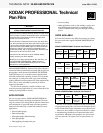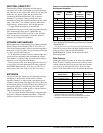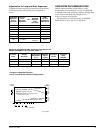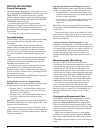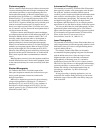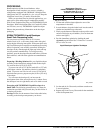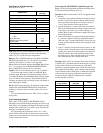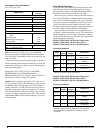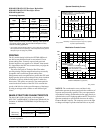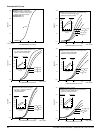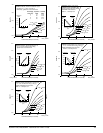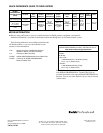
KODAK PROFESSIONAL Technical Pan Film • P-255 9
KODAK DURAFLO RT Developer Replenisher
KODAK DURAFLO RT Developer Starter
KODAK Rapid Fixer
Processing Sequence
PRINTING
The 0.1 neutral density built into the ESTAR-AH Base is
one-half to one-third that found in conventional 35 mm
picture-taking films. Correctly exposed and processed
pictorial negatives may appear to be “thinner” than normal.
It is important to take this into account when you judge the
printability of negatives.
The micro-fine grain of Technical Pan Film makes
possible printing at higher magnifications than are usually
acceptable with conventional picture-taking films.
Enlargements made at magnifications greater than 25X with
highly specular (point-source) enlargers may show a random
distribution of poorly defined white specks in otherwise
dense areas. The specks are caused by tiny matte particles
coated on the back surface of the film. You can mask the
specks, with little loss in the overall sharpness of the image,
by using an enlarger with a diffuse or semi-diffuse light
source.
IMAGE-STRUCTURE CHARACTERISTICS
The data in this section are based on development at
68°F (20°C) in KODAK HC-110 Developer (Dilution D) for
8 minutes or KODAK TECHNIDOL Liquid Developer for
9 minutes.
Step
No. of
Racks
Path
Length
Temperature
Develop 1 8 ft (2.4 m)
80 ±0.5°F
(27 ±0.3°C)
Fix 3 12 ft (3.8 m)
80°F (27°C)
nominal
Wash 2 8 ft (2.4 m)
70 to 75°F
(21 to 24°C)
Dry — 8 ft (2.4 m)
135 to 140°F
*
(57 to 60°C)
* Use a lower dryer temperature (95 to 110°F or 35 to 44°C) with 2415
Film if spots form due to rapid drying. Lower temperatures may also be
adequate if you are drying only roll film.
To produce a contrast index of about 1.4, start with a machine
speed of 8 feet per minute (2.4 m/min). Washing at this speed will
not provide archival quality, but it should be adequate for many
scientific recording applications.
KODAK Developer
HC-110 (Dilution D) TECHNIDOL Liquid
Diffuse rms
Granularity
*
* Read at a net diffuse density of 1.0 using a 48-micrometre aperture
and 12X magnification.
8 Extremely fine 5 Micro fine
Spectral-Sensitivity Curves
Modulation-Transfer Curves
NOTICE: The sensitometric curves and data in this
publication represent product tested under the conditions of
exposure and processing specified. They are representative
of production coatings, and therefore do not apply directly to
a particular box or roll of photographic material. They do not
represent standards or specifications that must be met by
Eastman Kodak Company. The company reserves the right
to change and improve product characteristics at any time.
Diffuse Density=
1.0 above D-min
0.3 above D-min
Diffuse Density=
700 750650600550500450400350300250
*Sensitivity = reciprocal of exposure (erg/cm ) required
to produce specified density
WAVELENGTH (nm)
2
LOG SENSITIVITY
0.0
1.0
2.0
1.0
*
3.0
F002_0194AC
KODAK HC-110 Developer (Dil D),
8 minutes at 68 F (20 C)
Process:
Effective Exposure:1.4 sec visible, 0.2 sec ultraviolet
8 minutes at 68 F (20 C);
KODAK TECHNIDOL Liquid Developer,
8 minutes at 68 F (20 C);
KODAK HC-110 Developer (Dil D),
TungstenExposure:
Process:Small tank,
1001 2 3 4 5 10 20 50 200 600
SPATIAL FREQUENCY (cycles/mm)
RESPONSE (%)
10
1
2
5
3
7
30
20
100
70
50
200
F002_0180AC



